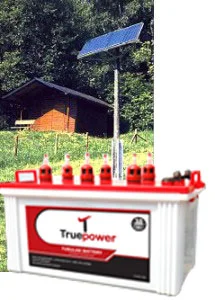Suryaurza Sysemize Deep Cycle Batteries
Deep cycle lead-acid batteries are used for off-grid solar & wind power systems, marine and industrial power applications. For remote power systems, traditional lead acid battery technology continues to dominate over other more modern battery technologies – mainly due to cost, predictable performance and high reliability.
‘Solar’ batteries are deep-cycle batteries which have been optimised by the manufacturers to be able to charge with very little current, and thus take maximum advantage of any available energy. Solar batteries also normally have a very high charge & discharge efficiency of around 90 to 95%.
‘Leisure’ batteries and ‘marine’ batteries are generally a cross between a starting battery and a deep cycle battery. They are cheaper than true deep cycle batteries due to the fact that they use less lead in their construction. A typical ‘marine / leisure’ battery will be somewhere in-between, with around 200 to 300 deep discharge cycles.
True deep cycle batteries have far heavier and stronger lead plates inside, which enables them to better withstand the stress of a deep discharge. It also makes them more expensive as the worldwide price of lead (Pb) is very high.
Rechargeable batteries
Rechargeable deep cycle batteries are a group of cells that store power using a chemical reaction as the catalyst. Each battery cell has a specific voltage output depending on the battery technology which is separate from the cell size. Batteries used for solar panels are similar to car batteries but constructed differently so they release their energy slowly rather than in a burst which is what car batteries do. Every cell in a deep cycle battery has either a single positive plate with a negative side or multiple positive and negative plates. The plates sit in a electrolyte solution, either gel (AGM) or liquid. This solution allows the negative and positive particles to flow between the plates. As the battery bank is discharged, the lead oxide becomes lead sulfate the sulfuric acid becomes water. In a fully discharged battery there is a very watery acid solution where the positive and negative electrons don’t go away, they change into a different form and are stored in the lead sulfate solution.




